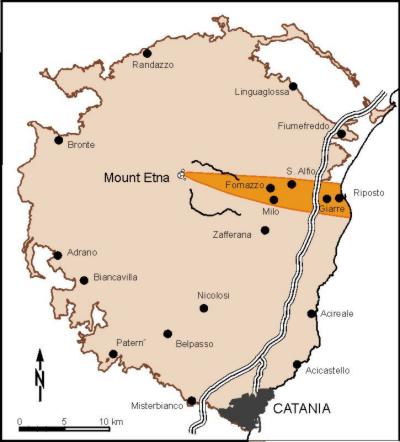
Sketch map showing
the distribution of pyroclastics of the 4 September 1999 eruption
of the Voragine, based on field work during the week following the
eruption. Click on the map for an enlarged version.
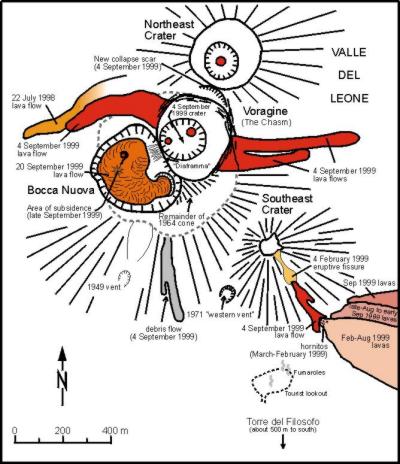
Sketch map of the
summit craters of Etna, based on fieldwork made between 7 September
and 1 October by Behncke and others.
|
WARNING: Access to the
summit craters is VERY DANGEROUS.
Strong explosive activity may occur at all four summit craters,
and visitors should not go to their rims or anywhere close to
the craters. Besides this, weather conditions are often unstable,
even during the summer; summit visitors may be surprised by
snowstorms (as occurred on 24 July 1999) or thunderstorms: one
man was killed by lightning at about 2000 m elevation near Piano
Provenzana on 30 August. Any person who enters the area beyond
the Torre del Filosofo mountain hut (2900 m elevation) or the
hut of the guides on the northern flank (Baita delle guide,
3000 m elevation) goes at his/her own risk and is not covered
by any insurance in case a rescue operation (e.g., with helicopters)
is necessary.
|
1 October 1999 visit to the
summit craters. The summit area of Etna was visited by
Boris Behncke (Dipartimento di Scienze Geologiche, Catania University),
Roberto Scandone and Lisetta Giacomelli (Dipartimento di Fisica, Università
"Roma Tre"), and Angelo Amara (Catania University) on 1
October 1999. Strong explosive (Strombolian) activity at the Northeast
Crater prevented the group from climbing on its cone: every few minutes
bombs were ejected up to 100 m above the crater rim, and many fell
onto the SW and S flanks of the Northeast Crater cone, to as far as
100-150 m away. Besides these larger explosions, loud roaring noise
was almost continuously heard from the crater, and emissions of ash
were frequent.
The western rim of the Voragine could be approached relatively easily,
and it was possible to look into the crater with its large pit formed
during the 4 September eruptive episode. No significant activity occurred
during about 10 minutes of observation. The Bocca Nuova was also quiet,
with only some gas emission from the northwestern vent which had produced
the latest major activity of the Bocca Nuova, on 20 and 21 September.
A roughly circular area of subsidence was present on the southern
side of this vent; subsidence had occurred at the same site in January-April
1998 and in October 1998.
The map of the summit craters shown above was drawn after fieldwork
on 28 September and 1 October; while relatively accurate for most
of the area, the eastern flank of the Voragine has been investigated
less thoroughly due to the presence of dense gas plumes drifting over
that area. The map will be updated if significant corrections are
necessary.
Report on a 28 September 1999
visit to the summit craters. Detailed observations of the
Northeast Crater, the Voragine and the Bocca Nuova were made during
a summit visit by Boris Behncke (Dipartimento di Scienze Geologiche,
Catania University) on 28 September 1999. These observations yielded
further detail about the effects of the 4 September Voragine eruption
and of the activity since then.
Northeast Crater. The entire Northeast Crater cone received
heavy fallout of bombs from the Voragine, and any trace of the footpath
that existed on its W side before that eruption has vanished under
a continuous cover of bombs, some up to 1.5 m in diameter. The configuration
of the crater itself has not changed much as far as could be ascertained;
however, a part of the crater area was veiled by dense, dark brown
to black ash plumes that were emitted from the active central pit
of the crater. A few fresh, black bombs with a maximum diameter of
0.3 m were lying on the W side of the cone and more were present on
the W and SW crater rim; these had been ejected by Strombolian activity
in the past few days. The collapse scar on the SW flank of the cone,
formed during the 22 July 1998 eruption of the Voragine, had been
largely healed by abundant bomb fallout from the 4 September 1999
eruption, but on the SSE side a further portion of the cone's flank
had collapsed, leaving a similar scar. The eruptive activity within
the active central pit consisted of near-continuous expulsions of
dark ash, and while standing on the rim of the pit, Behncke heard
frequent loud rumblings and the falling of rocks within the pit. Differently
from the incandescent ejections of the preceding days no incandescence
was seen during the 28 September visit, and virtually no view of the
interior of the pit could be obtained. However, good views were obtained
by Charles Rivière on 25 September, and these show that the
pit continues to a depth of several hundred meters with vertical walls,
its floor being invisible.
Voragine. A good panoramic view of the Voragine from
the S rim of the Northeast Crater revealed that the morphological
changes caused within this crater by the 4 September eruption were
less pronounced than had appeared from the descriptions of various
people who had visited the crater during the previous days. The former
"diaframma" and central vents had merged into one large
crater about 200 m wide, but it appeared that there were still two
eruptive centers at depth within this crater, whose positions coincided
with those of the former vents. Photos taken by Charles Rivière
on 25 September during a close approach to the crater show its interior
part to narrow at depth. The carving out of the new large crater within
the Voragine probably produced all the lithic blocks that were ejected
together with the more abundant fresh bombs on 4 September. On the
SW rim of this crater, a wide U-shaped gap had formed in the former
"diaframma" through which the crater floor of the adjacent
Bocca Nuova could be seen.
To the E and SE the new crater was surrounded by a fairly flat and
smooth area, similar to the crater floor on that side before the eruption;
the adjacent outer crater rim was much gentler than before. To the
N, NW and W the terrain was heavily fractured, but gas came from these
fractures which were oriented more or less concentrically. Similar
sub-concentric fractures were present on the outer ENE and E rim of
the Voragine and on a ridge which now constitutes both the SE flank
of the NE Crater cone and the NE rim of the Voragine.
A rootless, fountain-fed lava flow had formed during the 4 September
eruption on the W side of the Voragine as fluid ejecta accumulated
rapidly on the crater rim and the outer slope below. The upper part
of this flow was extremely craggy and heavily fractured; further downslope
its surface was composed of large, reddish brown blocks, similar to
the lava flow emitted on 22 July 1998 from the same crater. The flow
was up to 150 m wide in its upper part but narrowed to about 30 m
in its distal portion where it formed a lobe along the northern side
of the 22 July 1998 flow; the new lobe, however, was shorter than
its predecessor.
Two fountain-fed lava flows also formed on the E side of the Voragine.
They were essentially similar to the W flow but narrower. The longer
of these flows extended about half way down the slope towards the
W rim of the Valle del Bove. The source area on the W rim of the Voragine
was strongly fractured, with some of the fractures being up to 2 m
deep.
Eruptive activity within the Voragine during the 28 September visit
consisted of frequent loud explosions deep within the newly formed
crater, roughly in the location of the former central vent. No pyroclastics
were seen to rise to the lip of the crater although the noise of rocks
falling back into the active vent could be frequently heard. No fresh
ejecta were found while walking on the E and SE rim of the crater.
Bocca Nuova. This crater has changed most since last
seen by Behncke on 28 July. About 90 per cent of the crater floor
are covered with new lava which has buried most of the two eruptive
sites that had existed for at least four years in the NW and SE of
the crater. It is not clear if any of the lava originated at the Voragine
during its 4 September eruption - one might suspect some lava inflow
from there because the lava surface is clearly higher towards the
Voragine than in the SW and S part of the Bocca Nuova. There are,
however, no confirmed observations of lava within this crater immediately
after the 4 September event. The surface structure of the lava is
similar to that of the lava which was seen on the floor of the Bocca
Nuova in August 1998, possibly emplaced during the 22 July 1998 eruption
of the Voragine. In late July 1999 the two eruptive centers on the
crater floor were surrounded by low, broad pyroclastic cones; of these
only the one in the SE was seen to protrude partially from the new
lava during the 28 September visit. The SE vents themselves have completely
disappeared under the lava and have apparently not erupted since then,
but profuse steaming occurred from the margins of the lava fill. At
the site of the NW vents there was an irregularly shaped, shallow
depression that weakly emitted yellowish gas from several fumaroles;
no eruptive activity occurred during the visit, and none had apparently
occurred for several days before.
It appears that a portion, maybe several tens of meters wide, of the
W rim of the Bocca Nuova collapsed, enlarging the crater and lowering
the rim on that side. The lava surface on the crater floor lies only
about 30-40 m below that rim. In general, the Bocca Nuova is significantly
shallower in its NE, N and NW parts while its depth is greatest in
its SE part where the floor may have been raised by no more than 10
m.
Bombs that were a few days old littered most of the crater rim on
the S and SW side; these appear to have been ejected during the vigorous
activity on 20 and 21 September. Many actually fell as far as the
S and SW flanks of the main summit cone.
No close observations were made of the Southeast Crater and its cone
and of the area of ongoing effusive activity on the ESE base of the
cone. Photos taken by Charles Rivière on 25 September show
an irregular lava surface on the floor of the Southeast Crater, and
many incandescent spots and holes in that surface. Effusive activity
was reportedly continuing on 28 September, with small active lava
flows accumulating around the vents that became active on 10 or 11
September.
|
Recent
Etna photos (20-25 September 1999)
All photos
are courtesy of Charles Rivière (Tremblay-en-France,
France)
|
.jpg) |
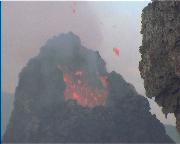 |
|
Mild
explosive activity at the newly formed hornitos on the ESE base
of the Southeast Crater cone, photographed on 20 September.
|
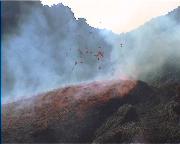 |
.jpg) |
|
Effusive
vent producing a lava flow, accompanied by vigorous spattering,
in the area of effusive activity on the ESE base of the Southeast
Crater cone.
Photo was taken on 20 September.
|
.jpg) |
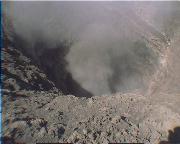 |
|
Two
views of the active central pit of the Northeast Crater
as seen from its E or SE rim on 25 September. The left photo
shows the pit during particularly clear viewing conditions while
in the right photo ash is rising from the floor of the pit.
|
.jpg) |
.jpg) |
|
Left:
A view onto the floor of the newly formed crater in the Voragine
as it appeared on 25 September, with an active vent located
in approximately the same position as the former central vent.
Depth of the crater is more than 150 m.
This photo was probably taken from the W rim of the crater.
Right: Magma bubbles exploding in two vents at the NW eruptive
site within the Bocca Nuova on the evening of 19 September,
shortly before a paroxysmal eruptive episode on the next morning.
|
.jpg) |
.jpg) |
|
Left:
Similar view to previous photo, Bocca Nuova, 19 September.
Right: The northern part of the Bocca Nuova seen from the W
crater rim on 20 September, a few hours after the eruptive episode
of that morning. The crater is flooded with fresh lava which
has mostly buried its source vent (located where the gas column
is issuing). This photo shows the "diaframma" with
the newly formed breach in the center background and the western
face of the Northeast Crater cone in the far left.
|
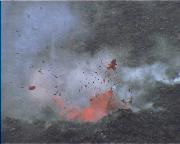 |
.jpg) |
|
Left:
Explosive burst from the NW vent of the Bocca Nuova on 20 September.
Right: Northern part of the floor of the Bocca Nuova seen from
W crater rim on 23 September. The NW vent area appears as an
irregularly shaped depression in the center of the photo; there
is no visible activity. The "diaframma" is visible
in the upper center of the photo.
|
.jpg) |
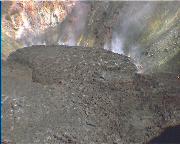 |
|
Left:
The northern part of the Bocca Nuova as seen from the W rim
of the crater on 23 September, showing the "diaframma"
and the Northeast Crater cone in the background.
Right: Lobe of lava erupted on 20 September that flowed into
the depression around the SE vent area in the Bocca Nuova, photographed
on 23 September. Note the profuse steaming on the flow margins.
|
.jpg) |
.jpg) |
|
The
crater floor of the Southeast Crater, seen on 24 September.
Incandescence is visible in numerous spots within the lava that
remained on the crater floor after
the activity of 4 September.
|
27 September update.
During the past week, eruptive activity has continued in Etna's summit
area. The most persistently active of the craters has been the Northeast
Crater which had deep-seated Strombolian activity within its central
pit. Marco Fulle (from the Astronomical Observatory of Trieste) observed
ejections of incandescent bombs on 22 and 26 September, some up to
one meter across, to several tens of meters above the lip of the pit,
but all ejecta fell back into the pit. Similarly, Charles Rivière
(of
Tremblay-en-France, France) observed incandescent
ejections from the Northeast Crater up to 80-100 m above the pit's
rim on 25 September.
The Voragine was visited by Fulle on several occasions between 22
and 26 September. The crater has changed beyond recognition after
the major eruption of 4 September and the activity in the following
days. It appears that there is now one single large pit-shaped crater
in the western or northwestern part of the Voragine, with a depth
of an estimated 200 m. A large intracrater cone has grown around this
pit, and this is surrounded by a moat which separates it from the
main rim of the Voragine. This intracrater cone is highest on the
eastern side, presumably because fallout during the 4 September eruption
was heaviest on that side. Much of the former "diaframma"
between the Voragine and the adjacent Bocca Nuova has collapsed. Two
rootless (fountain-fed) lava flows were emplaced on the ESE side of
the Voragine during the 4 September eruption. The longer of the two
flows is several hundred meters long while the smaller may be only
100-150 m long.
There was no activity within the Voragine during the first visits
by Fulle, and the crater was also silent early on 26 September, but
later that day, strong explosions occurred within the pit and dropped
bombs onto the crater rims. However, Rivière had observed similar
activity on 24 September, while Fulle was on the southeastern side
of the summit area to see the ongoing effusive activity.
No significant activity has been observed since 22 September at the
Bocca Nuova, and it appears that almost the whole crater floor is
covered with lava of the 20 September eruptive episode. Rivière
reported some kind of activity on 25 September, but its nature remains
unknown. On the evening of 19 September, Rivière had been eyewitness
of the onset of vigorous activity preceding the paroxysmal activity
early the next day. He observed (and filmed) the sudden uplift of
the entire crater floor and then escaped; there does not appear to
have been any explosive activity at that time. Renewed explosive activity
occurred at the Bocca Nuova on the evening of 21 September. Fulle
reports that of the features of the former crater floor, only the
northern rim of the southeastern cone is protruding through the20
September lava, and the vents in that cone themselves are covered
with lava.
Rivière visited the Southeast Crater on 24 September and reported
"lava" at a depth of about 20 m in that crater, but he saw
no eruptive activity. The lava may thus be a solidified plug formed
during the 4 September activity. Furthermore, a portion of the eastern
crater rim has collapsed over a width of about 20-30 m; during a visit
to the area by Boris Behncke (Dipartimento di Scienze Geologiche,
University of Catania) on 22 September no eruptive activity was seen
at the crater, but pulsating gas emissions came from the new collapse
area.
Effusive activity continues from the new vents (first seen by Giuseppe
Scarpinati on the morning of 11 September) near the 4 February eruptive
fissure, but this activity is by no means continuous and experiences
alternating surges and quiet periods. Lava flows have extended about
1 km downslope in that area and spilled down the western face of the
Valle del Bove to an unknown elevation. In the next few days fieldwork
will hopefully reveal more detail about the extent of new lava.
Interviews with people working at the tourist complex at Piano Provenzana,
on the northern flank of Etna, have furnished interesting new details
about the 4 September eruption of the Voragine. The event was well
visible from there while the summit was veiled by dense clouds on
all other sides. Photographs taken by a mountain guide from the area
near Pizzi Deneri, at about 2600 m elevation on the northern flank,
show an impressive lava fountain jetting to a height of more than
1500 m above the summit, dwarfing the prominent cone of the Northeast
Crater which is visible at the base of the fountain. Such fountain
heights have not been recorded at Etna before (about 600-700 m were
reached by lava fountains from the Southeast Crater in September 1989),
and this points to the magnitude of the 4 September event which was
among the three most violent summit eruptions of the past 100 years
(similar eruptions occurred on 17 July 1960, from the Voragine, and
on 5 January 1990, from the Southeast Crater). It is hoped that field
work during the next few days to weeks will render a comprehensive
idea of this event, and that some of the photos made on the northern
side of the volcano will be made available for this web site.

visitors counted since 12 February 1999
(more than 10,000 during the first 3 weeks!)
FastCounter
by LinkExchange
Page set up on 27 May 1997, last modified
on 5 October 1999

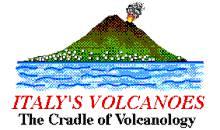

.jpg)


.jpg)
.jpg)

.jpg)
.jpg)
.jpg)
.jpg)

.jpg)
.jpg)

.jpg)
.jpg)